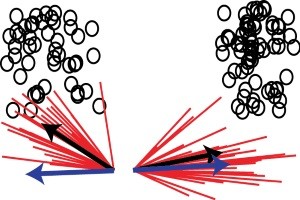Neupane S, Guitton D, Pack CC. Two distinct types of remapping in primate cortical area V4. Nat Commun. 2016 Feb 1st.
Scientific Impact: This article uncovers an important finding to better understand a function of the brain fundamental to visual perception. First pointed out by Ernst Mach in 1897, the continuous perception of the visual world despite disruptive eye movements, is an important property of our visual system. Understanding the mechanism of this property brings us closer to understanding the sensorimotor integration that our visual system undergoes everytime we make an eye movement. Since eye movements have now begun to be used as a diagnostic tool for many neurological diseases such as Parkinson’s Disease, Fetal Alcohol Spectrum Disorder, understanding the role of eye movements in visual perception can potentially lead to the development of novel non-invasive and simple diagnostic methods.
Futhermore, my research has set a robust ground to study the encoding of space in the brain which has puzzled philosophers for centuries. We know now that the topographic organization of visual receptive fields, which systematically encodes the visual world in a ego-centric coordinates during stable fixation, gets re-organized transiently during eye movements. Such re-organization futher varies with the vector of eye-movements. In such a senario, how the brain tracks the identity and location of objects in the containing visual space is a mystery. We can now design experiments to solve some of these mysteries by using the foundation of my research finding of receptive field remapping.
* * *
Original Abstract
Visual neurons typically receive information from a limited portion of the retina, and such receptive fields are a key organizing principle for much of visual cortex. At the same time, there is strong evidence that receptive fields transiently shift around the time of saccades. The nature of the shift is controversial: Previous studies have found shifts consistent with a role for perceptual constancy; other studies suggest a role in the allocation of spatial attention. Here we present evidence that both the previously documented functions exist in individual neurons in primate cortical area V4. Remapping associated with perceptual constancy occurs for saccades in all directions, while attentional shifts mainly occur for neurons with receptive fields in the same hemifield as the saccade end point. The latter are relatively sluggish and can be observed even during saccade planning. Overall these results suggest a complex interplay of visual and extraretinal influences during the execution of saccades.
Receptive field shift vectors of visual neurons in area V4 of primate brain due to saccadic eye movements.



